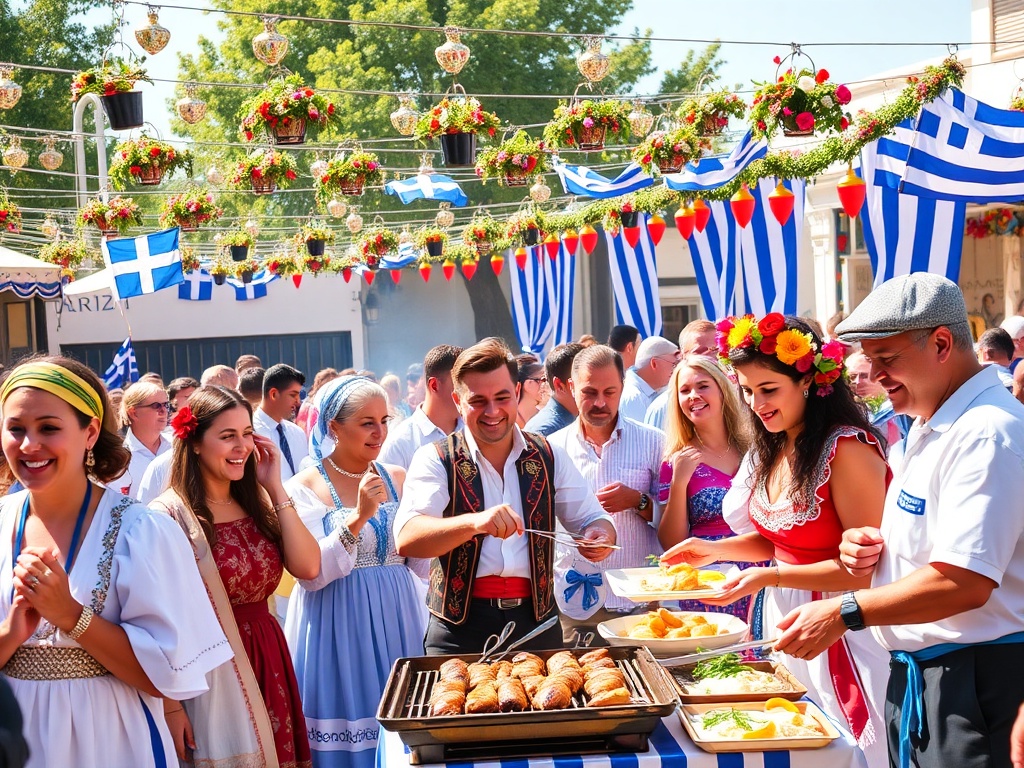Greece, a country steeped in history and culture, is known for its rich tapestry of traditions that reflect the diversity and unity of its people. From ancient rituals to contemporary customs, these traditions vary significantly across regions, each offering a unique insight into the Greek way of life. Here, we delve deeper into five notable traditions that showcase the vibrancy and uniqueness of Greece.
1. Name Day Celebrations
In Greece, name days hold a special significance, often overshadowing birthdays in terms of importance. Each day of the year is dedicated to a specific saint, and those named after that saint celebrate their name day with great enthusiasm. The tradition is deeply rooted in the Orthodox faith, where saints are revered and their names celebrated.
The Celebration Process
On their name day, individuals typically host an open-house gathering, inviting friends, family, and neighbors to join in the festivities. The atmosphere is filled with joy, laughter, and the aroma of delicious food. Guests bring gifts, usually flowers or sweets, to honor the celebrant. Traditional sweets, such as baklava and loukoum, along with local wines, are often served, symbolizing hospitality and generosity.
Cultural Significance
Name days foster a sense of community and connection among people. They provide an opportunity for socializing and strengthening bonds, as the celebrations often extend beyond family to include friends and acquaintances. This tradition reflects the Greek value of philoxenia, or love for strangers, emphasizing the importance of welcoming others into one’s home.
2. The Apokries Festival
Apokries, or the Greek Carnival, is a vibrant and colorful celebration that precedes Lent. Spanning three weeks, this festival is marked by lively parades, extravagant costumes, and festive gatherings. Each region has its unique interpretation of Apokries, making it a diverse celebration across Greece.
Regional Variations
In Patras, one of the largest carnival celebrations takes place, featuring elaborate floats, music, and dance. The city transforms into a carnival haven, drawing thousands of visitors. In other parts of Greece, such as the island of Corfu, the festival is celebrated with traditional music and folk dances, showcasing local customs and culture.
Community Spirit
The spirit of Apokries is rooted in the idea of freedom and expression. People of all ages participate by dressing in costumes, often reflecting satire and humor. This tradition allows individuals to break away from societal norms and embrace a carefree attitude. The festival culminates in a grand parade, where the community comes together to celebrate unity and joy.
3. The Art of Tsiknopempti
Tsiknopempti, or “Smoky Thursday,” is a delightful tradition celebrated during the Apokries festival. It marks the last Thursday before Lent, and it is a day dedicated to feasting on grilled meats.
Culinary Traditions
On this day, families and friends gather for outdoor barbecues, cooking various types of meat, including lamb, pork, and chicken, over open flames. The name “Tsiknopempti” derives from the smoke that fills the air as meats are grilled, creating a festive atmosphere.
The Festive Experience
The joy of Tsiknopempti lies not only in the food but also in the communal experience. It is a day filled with laughter, music, and camaraderie, where people share stories and enjoy each other’s company. Traditional songs are sung, and the celebration often involves local wines and spirits, enhancing the festive spirit.
4. Easter Traditions
Greek Orthodox Easter is perhaps the most significant religious celebration in Greece, marked by a series of unique traditions that reflect the country’s deep-rooted spiritual beliefs and cultural values.
Midnight Resurrection Service
One of the most anticipated events is the midnight Resurrection service held on Holy Saturday. Families gather in churches, where they participate in a candlelit service that culminates in the joyous proclamation of Christ’s resurrection. As the clock strikes midnight, the church bells ring, and worshippers exchange the greeting, “Christos Anesti” (Christ is Risen), followed by “Alithos Anesti” (Truly He is Risen).
Festive Feast
After the service, families return home to break the Lenten fast with a grand feast. Traditional dishes include roasted lamb, a symbol of sacrifice, and red-dyed eggs, representing the blood of Christ. The sweet bread, tsoureki, is also served, often braided and adorned with sesame seeds. This feast is not just a meal; it is a celebration of life and renewal, bringing families together in gratitude and joy.
5. The Art of Ikebana in Crete
In Crete, a unique tradition involves the art of Ikebana, a Japanese floral arrangement, adapted to fit local customs. This practice has become a beautiful expression of Cretan culture, particularly during festivals and special occasions.
Cultural Fusion
During weddings and various local festivities, Crete’s artisans create intricate floral displays using native flowers and herbs. The arrangements often reflect the island’s natural beauty, showcasing vibrant colors and fragrant herbs. This blending of cultures highlights the island’s openness to influences while maintaining its unique identity.
Symbolism in Arrangements
The art of Ikebana in Crete symbolizes harmony, balance, and respect for nature. Each arrangement tells a story, often reflecting the emotions and sentiments of the occasion. This tradition fosters creativity and artistry, allowing individuals to express their feelings through floral design.
Conclusion
These five traditions offer a glimpse into the rich cultural heritage of Greece, showcasing the diversity and unity of its people. Each practice, whether through name days, festivals, or culinary delights, serves to strengthen community ties and celebrate shared experiences. As Greece continues to evolve, these traditions remain vital, preserving the essence of Greek identity for future generations. Embracing these customs allows both locals and visitors to appreciate the vibrant spirit of Greece, where history and modernity coexist in harmony.
